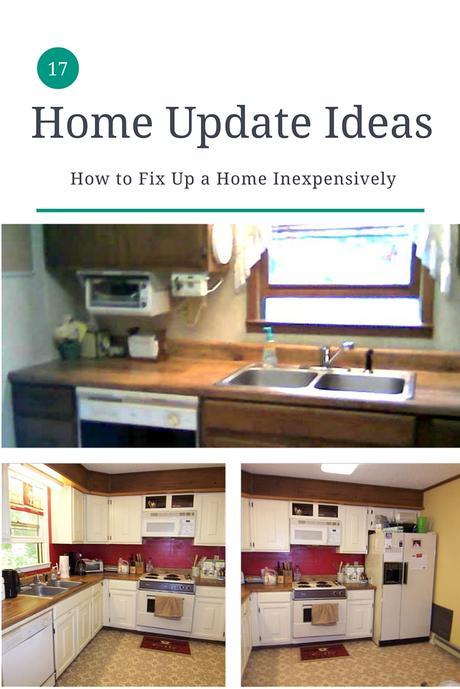With all the HGTV examples available, it’s easy to get ideas on how to update a house inexpensively. But they never seem to answer one question: Why is it that home improvement never becomes a priority until it’s time to move?
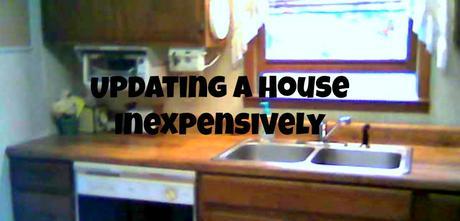
I don’t have an answer to that. To be honest, we were just as guilty of putting off our To-Do list as the next person. Okay, we did a lot of minor updates along the road, but we put off knocking out walls until we decided to move overseas. We thought it would create a lot of upheaval and interruptions to our lives. It did, but it was worth it in the end. There was no way we could sell our home as-is in a soft real estate market.
Expat wanna-bes
Wanting to move overseas where life is slower and cheaper, we did plenty of reading about every possible to make a house look attractive to buyers, and watched more episodes of Design on a Dime than we probably needed to. Problem was, we put the actual action on the back burner for years.
It was setting a deadline that finally got us out of that lazy mindset. We decided on a move date and told people about it so we would have to do it. No matter that someone else would enjoy the fruits of our labors. We would enjoy something even better: A new life in a new place. There’s nothing like setting a goal to get you moving. We focused on Our Expat Adventure and it really helped motivate us.
Home updating, baby steps style
Those Better Homes and Gardens home update features are fabulous – until you see how much it actually cost. Ouch! Certainly out of our budget. But here’s the thing: A big chunk of the cost comes in the actual building materials. We kept our eyes open for sales at the big box stores and scoured the bargain racks at Wal-Mart, buying what we knew we would need down the road. Going bit-by-bit as we did is a great way to avoid a serious dent in the checkbook. Besides, doing it that way made paying for our home update project a lot less daunting. Practically painless, even.
Here is a brief account of how we changed our split-level house since we first moved in. I originally wrote it to journal what we did along the way but now that it’s finished, hopefully it will give you a few ideas of your own.
Tip: To save money, borrow power tools from generous friends. Who knows, the more nervous ones might even offer to help!Easy 1970s living room update
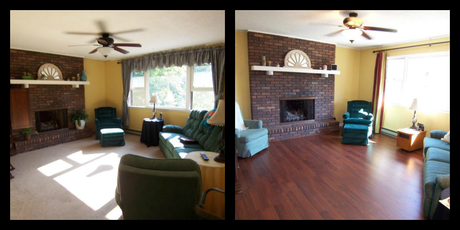
1. Wall color.
Purchased: one 5-gallon bucket each of paint and matching tinted primer in a bright, cheery color, plus painting supplies. (We didn’t need quite that much paint, by the way.)
Go ahead and roll your eyes: Our living room was “blessed” with that dark, fake-wood wall paneling that was so popular in the 1970s. The dining room was an ugly, faded mint green. (Omigosh. Can you say hospital?)
It’s amazing what a little bit of paint can do—and yes, we primed/painted right over everything, even though the previous owners were heavy smokers. This made the dining and living rooms feel like they were covered in sunshine so we carried the color down the hall and into the foyer. Great for us, but with 20/20 hindsight, maybe we should have gone with something a little more neutral to make it appeal to more buyers on the back end.
2. Bright white trim.
Purchased: One quart of white latex enamel and one paint brush.
Painting baseboards, doors and trim freshened everything up and covered dings and dents.
3. New laminate flooring
Purchased: Laminate flooring, bought from a big box store when it was on sale. (Comparison shopping really pays off here.)
The carpet was so ugly that we finally ripped it out and lived with the subflooring until we could afford something better. It’s a good thing we did: The previous owner had been suffering from respiratory problems, and powdery mold was hiding underneath the padding. Mold inspector’s advice: Sweep up what you can, then spray the floor with hydrogen peroxide – you know, the stuff in the brown bottle that people use on cuts.
As for labor, tearing out carpets is quick and easy, not to mention fun enough that your kids would beg to do it. The tack strips were just as easy, only needing the claw side of a hammer to remove. We rolled everything up and hauled it to the dump in the trunk of our car.
We installed most of the tongue-and-groove laminate ourselves—it was really easy, actually.—but we did hire a pro to do the more difficult parts at the end. Cost for his labor: about $250.
4. New, modern overhead fan
Purchased: A new overhead fan with multiple speeds and a remote control. Not to mention a modern look to replace the dated and noisy one. Cost: about $70.
Updating a 1970s kitchen
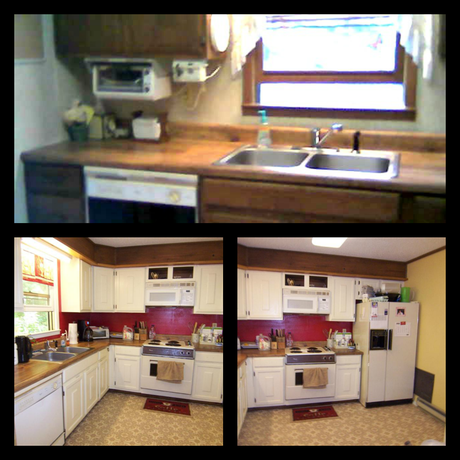
5. New wall color.
The day we moved in we pulled off the kitchen’s original, faded floral wallpaper. With one tug. Yikes. After sanding the walls we painted the kitchen walls with some of the living room’s paint. Cost: about $5 for a package of sandpaper; we already had rollers and brushes
6. Feature color.
The under-cabinet wall behind the stove got a pop of color. We skipped the primer because we’d just painted the room. Cleanup took more time than the painting itself. Cost: $10 for a quart of bright red paint.
7. White trim
Painting the baseboards and wood trim white only took an hour. We painted the windows, trim and baseboards in both the kitchen and living room at the same time. Cost: $10 for a quart of paint.
8. New cabinet color and hardware.
Wrought iron hardware is incredibly old-fashioned, and dark wood can make small rooms feel dismal. We removed all the old hardware, filled the holes, and painted the cabinets vanilla white. Instantly it brightened everything up and made the kitchen feel much cleaner. As the cabinet doors had finger pulls, we didn’t need new hardware. The hardest part was removing the doors, but the end result made us glad we hadn’t skipped that step. Counting filler- and paint-drying time, it was a weekend project. Cost: about $50 for paint and wood filler.
9. New counter top.
Goodbye, Formica burn marks! We replaced the worn counter top with a stock one from Lowe’s in a neutral, granite pattern. The big challenge was getting a smooth cut on the ends, but we managed okay with a couple of tips from friends. (You can see it in the photo from the demolition phase.) It took about a day. Cost: About $200.
10. New faucet.
Replacing the counter required disconnecting the kitchen sink. Perfect time for a new, updated faucet, one with a high arch to create better sink clearance and an airier ambiance. (You can see it in the photo from the demolition phase.) Cost: About $200.
Updating a 1970s kitchen (phase 2)
This happened a few years later. It was well overdue.
11. New open floor plan.
We tore out two kitchen walls ourselves. I’ll admit, it was more fun than it probably should have been.
12. Glazed cabinets.
We washed, then glazed the vanilla colored cabinets with a warm brown (Sherwin Williams French Roast). It hid a lot of imperfections and gave the cabinets a high-end look. Gorgeous! Had I known how easy and fast it would be (less than an afternoon), I’d have done it in phase 1.
13. New hardware.
Brushed nickel hardware on the new cabinets and drawers added a bit of bling. Cost: less than $100.
14. New kitchen appliances.
This took a huge bite out of our finances but it was so worth it. To economize we bought floor models from the scratch-and-dent area of the big box store, one by one. We stuck to a black finish on everything to ensure it would match.
15. New kitchen island with breakfast bar.
This took the most planning because we wanted to install it right over the area where the kitchen wall had been. Okay, the real reason was that we didn’t want to rip up our newly installed flooring. We found model closeouts at Home Depot and adjusted our design for the cabinets that were available. The finish was different, but that’s a current trend so I didn’t bother with painting and glazing to match.
Remember the Formica counter top we had installed in Phase 1? Using the same stock pattern on the island tied the entire kitchen together into one cohesive whole. A carpenter laminated the new breakfast bar with matching sheets of Formica.
16. New lighting.
Goodbye, fluorescent fixtures! Removing the overhead fluorescent created a hole in the ceiling. Patching, then painting the ceiling was long overdue. We added a few well-placed can lights on a dimmer and then put two pendants over the breakfast bar on a different switch. We saved money by hiring a friend in the home improvement business and offering to be his assistant.
17. New window treatments.
A multicolored striped valance, hung high to admit more light, added some personality and warmth. The red stripe matched the wall. A cheap, white mini-blind from Wal-Mart offered privacy. Cost: About $25.
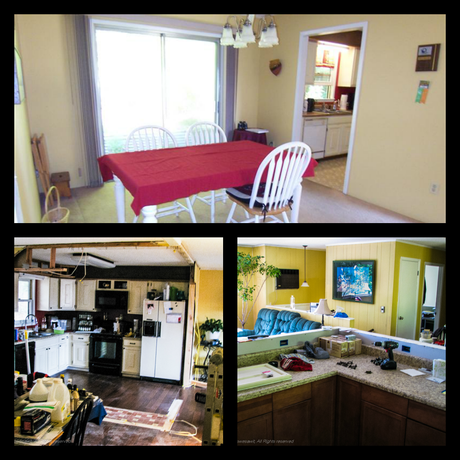
Inspired?
Save this pin to your home decorating board on Pinterest, then click here for a second home improvement story, where I share a couple more of our 1970s home improvements.
